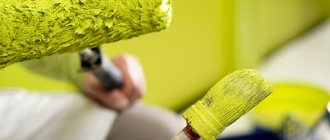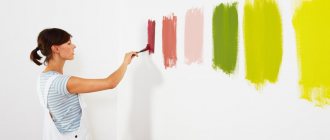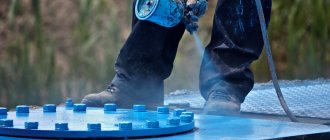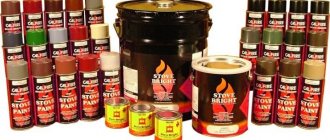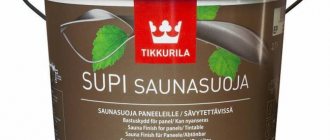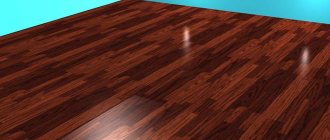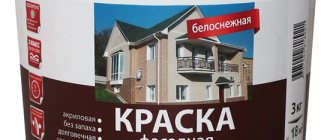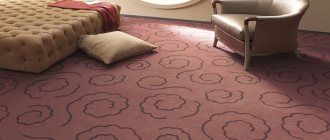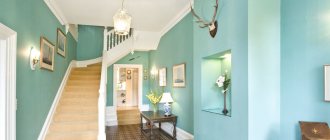Painting the ceiling is an important stage when carrying out finishing work in a residential or public space. To achieve optimal results and long-term operation of the finished surface, it is necessary to choose the most suitable paint and varnish composition for interior work. Ceiling paint must meet the conditions of environmental safety, practicality, reliability, durability and other important criteria. One of the most popular types of finishing materials for ceilings is acrylic paint, which has a low price and excellent performance properties.
Ceiling painted with acrylic paint
Feature of acrylic
Paints of this type are produced chemically by adding methacrylic acid, which has the following features:
- The synthesis of the material makes it possible to obtain a homogeneous polymer composition that is not subject to biological decomposition and retains its performance properties in an aquatic environment.
- Synthesized acrylic granules dissolve well when carrying out chemical reactions with some other substances.
- Acrylic firmly holds the pigment and is painted over the entire volume.
- Dissolved acrylic quickly polymerizes, forming a high-strength film that is resistant to mechanical stress and negative environmental influences.
Acrylic granules
These properties, discovered by chemists during the repeated synthesis of acrylic acids, made it possible to obtain a high-quality paint and varnish composition, the scope of application and performance qualities of which are improving every year.
Material characteristics
The fiberglass panel contains a large number of unidirectional threads, no more than six microns thick. They are fastened together with polyester resin, due to which the material has a homogeneous structure, and the finished product is highly durable.
This structure of fiberglass provided it with a number of features:
- Sound absorption, which is achieved by paralleling the fibers of the slabs. This promotes absorption of the sound wave rather than reflection, which reduces the effect of echo in the room;
- Moisture resistant. The material does not absorb water due to the fact that it does not have capillaries. This property of fiberglass can be called unique, since such a structure is unique to it. Therefore, the liquid that gets onto the surface of the structure or inside during cleaning will instantly evaporate, leaving no traces;
- Fire resistance. In order to further improve this property of the product, it is coated with special compounds;
- Dust protected. Caring for a fiberglass ceiling is not difficult. Cleaning is done using a vacuum cleaner. Also. The surface can be wiped with a damp cloth using a synthetic detergent. If there is a need for mechanical cleaning, it is quite possible.
Advantages of acrylic paints
Modern acrylic decorative and protective materials, widely used in interior finishing work, have many advantages when comparing them with similar compositions:
- Quick drying of the applied composition, subject to the recommended layer thickness.
- Due to the presence of a dense polymer film, the coating has increased wear resistance. With minor mechanical impact, scratches do not form on the surface.
- The elastic polymer included in the composition allows you to smooth out small defects and cracks in the preparation of the ceiling when applying and polymerizing a viscous substance.
Elastic coating after drying
- Increased resistance to prolonged exposure to ultraviolet radiation.
- Fire safety of all components included in the paint.
- Increased moisture resistance and preservation of functional features during sudden temperature changes, which significantly expands the scope of application of the material.
- Possibility of wet surface cleaning.
- When applied, the composition does not emit a specific odor, does not emit toxins, and does not cause irritation to the human respiratory tract.
- Most compositions spread evenly on the prepared surface and are characterized by increased efficiency - the average consumption, when applied in 1 layer, is no more than 130 - 200 g/m2.
Eco-friendly acrylic paint
Acrylic paint, depending on the concentration of pigments, is available in different shades and can be easily tinted directly at the point of sale. The presence of universal binding components allows the substance to be used when applied to any type of surface.
Preparation of aqueous emulsion
The best result of painting a surface depends on the correct mixing of the composition to obtain the required thickness.
It should be remembered that a thick and unmixed emulsion does not hide the joints between paint stripes well.
After opening the bucket, the acrylic mass should be thoroughly mixed with a special mixer with a drill until smooth.
Anti-mold and mildew components are added to the emulsion, which are highly resistant to washing. If it is indicated on the bucket that it can be diluted by 5-10% by weight, then for a weight of 10 kg you can add 50 - 100 milliliters of water.
Masters of finishing work believe that the acrylic mass must be diluted to the state of milk if you are going to paint the surface in two or three layers.
Disadvantages of acrylic paints
Despite the presence of many advantages, experts and consumers highlight some disadvantages of this finishing material when applied to the ceiling:
- Like any other interior paint, the composition is applied to a smooth surface of a large area in a thin layer. In this regard, any unevenness or sagging in the rough finish inevitably affects the quality of the finishing coating, which requires increased attention when preparing the ceiling.
- Acrylic paint is a popular product and most manufacturers compete to achieve the cheapest retail price. This often leads to a decrease in the quality of the material and a deterioration in its performance characteristics.
- Acrylic-based paint is capricious in the choice of tool for its application. When using rollers or brushes with insufficiently soft bristles, bristles or fur, stripes appear on the surface, which spoil the appearance of the finish.
Painting tool
It should also be mentioned that from batch to batch, the shade of paint may change, since the manufacturer or technologist in the store is not able to control the pigment dosage with an accuracy of milligrams. When buying paint, you need to accurately calculate the volume and tint the entire amount of material at once with a single dosage, so that after application the surface is the same shade.
Design ideas
The ceiling is a very important part of the interior.
How the room will be perceived largely depends on how you decorate it. If you like minimalism or Finnish style, then you shouldn’t make the ceiling bright and filled with a variety of patterns. A monochromatic finish is best. Choose a color you like and work only with it. It is recommended to give preference to light colors as they help visually make the room taller.
Ceilings decorated with all kinds of designs look more interesting. These can be abstract patterns created with thin brushes, or full-fledged drawings. However, creating them is more difficult.
Painting the ceiling over an old layer of paint is not such a difficult job. You can easily and quickly change the look of a room with your own hands and create the design of your dreams.
To learn how to paint a ceiling, see the following video.
Tools needed to apply acrylic composition
To achieve an impeccable result, you need to stock up on a set of high-quality painting tools, which includes the following items:
- Roller with soft faux fur. The tool should absorb the paint well and hold it inside without splashing.
- A set of brushes with soft bristles for finishing corners and joining ceilings with walls in hard-to-reach places.
- A tray with a grooved surface for rolling out the roller and removing excess paint from it.
Roller with tray
If several rooms in an apartment or house are to be painted, and the total ceiling area exceeds 100 - 150 m2, an advisable solution would be to use a spray gun, which will ensure uniform application of a layer of acrylic paint in a short time.
Proper care of polystyrene tiles
In addition, a number of precautions must be observed:
- It is advisable to place lighting fixtures open from the ceiling at a distance of at least 30 centimeters from the tiles, since polystyrene foam can deform when heated (it is thermoplastic);
- when the chandelier has been purchased and already installed in place, you can simply replace ordinary incandescent lamps with energy-saving light bulbs, which heat up much less;
- To wipe laminated tiles, it is better to use a damp sponge, which should be moistened with soapy water or detergent (without abrasive particles). If the surface of the material is grainy, then it is advisable to wipe it with a dry cloth;
- small stains can be easily removed with a regular eraser, but you should not press it hard; polystyrene foam can be easily pressed through.
Types of acrylic paints
Depending on the composition, functional features, hardening time and wear resistance, acrylic ceiling paints are divided into 4 main types, each of which is described in detail below.
Water-dispersed
This type of paint contains special film-forming substances that are formed during polymerization, creating a reliable protective barrier. Advantages of this type of paint:
- Increased hydrophobization with unchanged vapor permeability makes it possible to apply the coating in bathrooms or kitchens. Condensation does not collect on the surface, which prevents the growth of bacteria and the formation of fungus.
- The synthetic components included in the substance do not cause allergic reactions.
- When heated, the paint does not release toxins or odors, maintaining its performance properties.
- Belongs to the class of fireproof non-combustible substances.
- It is characterized by increased durability - when choosing a paint coating of this type from a well-known manufacturer, the surface can operate for 10 years or more.
Water-dispersion "Bolars"
In addition to the advantages, this paint and varnish composition has several subjective disadvantages:
- Poor frost resistance, which limits its use in open spaces - balconies and terraces.
- When applied, the composition deteriorates from any concentration of humidity and loses its properties.
- During polymerization, it is necessary to avoid strong drafts, as stains will appear on the surface.
These disadvantages are conditional, and water-dispersion paint is widely used when finishing ceilings in any room
Vinyl acrylic
This type of paint is used exclusively for interior work and, like the previous composition, belongs to water-soluble coatings. Has the same advantages as water-dispersed materials.
The disadvantages include insufficient resistance to any type of acidic or alkaline compounds, which is why the finished ceiling surface is difficult to wet clean. In addition, after application, the composition decreases in volume due to strong shrinkage, which can contribute to the formation of cracks that open during operation.
Vinyl acrylic Dali
Currently, vinyl paints are used less and less, as new, more effective polymer compositions are gradually replacing this obsolete material.
Acrylic silicone
This type of paint coating belongs to materials of a higher price category due to its versatility. Can be used for interior or exterior work, fits perfectly on any type of surface. Some advantages of the composition:
- The silicone additive increases the moisture resistance of the ceiling coating.
- Increased elasticity reduces the risk of cracks due to the integrity of the preparation of the lower part of the floor slab.
- High frost resistance.
- Increased resistance to most chemicals allows wet cleaning with the use of certain cleaning products.
- Easy to apply with a roller or spray gun.
- Applies evenly to concrete, plaster, wood, plasterboard and other surfaces.
- Polymerizes quickly - average drying time is no more than 2 hours.
- Serves for more than 10 - 15 years without the need for new finishing work.
There are few disadvantages to this substance, but they are:
- Increased price compared to other types of acrylic paints.
- Used in combination with a special type of penetrating primer.
- When applied to a dusty surface, the adhesion of the composition is reduced several times.
Acrylic silicone Marshall
Acrylic silicone paint is in high demand among country property owners for decorating ceilings and walls of open spaces, since the original purpose of the material is finishing the facades of buildings.
Styrene acrylic
When synthesizing this composition, a special type of polymer is used, which has the following advantages:
- Increased resistance against negative environmental influences. The composition can be used both indoors and outdoors.
- After polymerization, this type of paint has increased mechanical strength, does not generate dust and does not scratch.
- Does not lose its performance properties when in contact with a damp surface, in direct sunlight and in other aggressive conditions.
Styrene acrylic Belinka
The main disadvantage of this paint is the increased retail cost. However, taking into account the average service life of 12 - 15 years as part of the coating, the slight cost overrun when purchasing is compensated by durability.
Roller painting
What is special about this method? This option is the most common because it is very practical and allows you to complete the work in the shortest possible time. But here it is very important to choose the right roller for painting with acrylic paint. Its dimensions depend on the area of the room. As a rule, a tool with a medium cylinder is used, allowing for wide stripes. To work with it, you will need a special bath into which the coloring mixture is poured.
The technology for working with a roller is as follows:
- The container is half filled with paint. The instrument is completely dipped into it so that it is well saturated with the composition.
- Next, excess mixture is removed from the cylinder. To do this, several rotational movements are made on a special board located in the bath. Thanks to this, you can paint the ceiling more evenly and avoid the formation of streaks and stains.
- The tool moves in a direction away from you. In this case, you should strive to maintain an angle of 45 degrees.
- Don't put too much pressure on the roller. Otherwise, there will be drips on the working surface.
- To make the ceiling look uniform after painting, the stripes are arranged crosswise.
When all work is completed, the instrument is washed and dried. If the paint dries, it will no longer be possible to use it in the future.
TOP 5 best manufacturers
The market offers a wide range of acrylic paints from various manufacturers, competing with each other in terms of quality, reliability, wear resistance, ease and uniformity of application, as well as price. Below is a rating of the best manufacturers of acrylic-based ceiling paints that are in active demand among the population in 2022 - 2021.
Tikkurila
One of the world's most famous manufacturers of paint and varnish coatings, founded more than 150 years ago. The company's products are in high demand among professionals and amateurs in more than 100 countries around the world.
Acrylic ceiling paints produced under this brand are distinguished by increased quality, ease of application, durability, resistance to ultraviolet radiation and other qualities. The company represents the following brands of ceiling acrylic paints, which are in active demand among consumers:
- Tikkurila Harmony (average price 850 – 950 rubles per 0.9 l);
- Tikkurila Liitu (1400 – 1600 rubles for 0.9 l);
- Tikkurila Siro Himmea (750 – 850 rubles for 0.9 l);
- Tikkurila Lumi (2400 – 2700 rubles for 2.7 l).
These products are one-component coating compositions that can be applied either manually or mechanically. The average consumption does not exceed 150 ml/m2. The factory composition of such materials is characterized by the absence of color - the paint is tinted at the point of sale, according to the customer’s choice from the presented catalog.
"Lakra"
The largest paint manufacturer in Russia, whose factories are also located in some CIS countries, Poland, Switzerland and Germany on the basis of official partnership agreements. The products are in no way inferior in quality to famous European brands, and in many respects even surpass them. The following set of acrylic paints from this manufacturer is available on the market:
- “Interior acrylic varnish” (350 – 400 rubles for 3 kg);
- “Acrylic varnish for wallpaper” (650 – 750 rubles for 3 kg);
- “Acrylic varnish for ceilings” (200 – 250 rubles per 3 kg).
All Lakra paint is produced in a convenient plastic container-bucket with a handle, which allows it to be sealed tightly after use and has a long shelf life.
VGT
A German brand with full-cycle production in the Russian Federation. The plant has modern European equipment, and all products coming off the assembly lines are subject to careful quality control by representatives of the parent organization. The following brands of acrylic paints suitable for application to the ceiling are widely available:
- VGT VD-AK-1180 (320 – 350 rubles per 1.5 kg);
- VGT VD-AK-2180 (170 – 210 rubles per 1.5 kg);
These paints are tinted at the point of sale. The base includes an elastic polymer that creates a film coating. During long-term use, the surface does not fade in the sun, does not scratch and does not lose its performance properties. Can be used in any premises with high levels of humidity and sudden temperature changes.
"Tex"
Russian brand with a plant in the Leningrad region and a central office in St. Petersburg. The company has existed for more than 20 years and distributes its products not only throughout the Russian Federation, but also abroad. The increased demand is due to the environmental friendliness, reliability and durability of each product. The following types of interior acrylic paints are available on the market:
- “Tex Universal” (220 – 270 rubles per 3 kg);
- “Tex for interiors” (150 – 170 rubles per 0.9 l);
- “Tex Profi” (200 – 250 rubles per 0.9 l).
Acrylic compositions "Tex" go well with the manufacturer's own primer. All paints can be easily washed off after polymerization and can withstand exposure to acidic and alkaline environments.
Dufa
A German brand with a 65-year history, whose products are familiar not only to professional craftsmen, but also to most ordinary people who have encountered the decoration of premises. The quality of the products is evidenced by a customer base of many thousands in more than 100 countries, as well as the presence of official production and sales offices in many countries of Asia and Europe, including the Russian Federation.
The consumer can purchase the following brands of acrylic paints of this brand:
- Dufa Premium KeraLine 3 (350 – 400 rubles for 0.9 l);
- Dufa Premium KeraLine 7 (400 – 450 rubles for 0.9 l);
- Dufa Premium Arctic (450 – 500 rubles per 1.0 l);
- Dufa Premium Velor (4500 - 5500 rubles for 9.0 l).
When releasing products, the company pays increased attention to the environmental safety of each component included in the paint. The coatings from this plant are recommended for use in children's and medical institutions.
This rating is based on real consumer reviews, is subjective in nature and is not a direct indication to purchase the material.
Reliability, durability and insulating properties
If we talk about reliability, durability and insulating properties, then each type of stretch ceiling has its pros and cons. To make the right choice, let's look at them briefly.
PVC ceilings
Advantages:
- durability - up to 12 years;
- the ability to withstand pressure up to 100 kg/m2 (when the apartment is flooded by neighbors from above, the PVC film stretches but does not tear, and the water can be drained through the hole for the chandelier);
- practicality and low cost;
- variety of colors and textures;
- the possibility of using a more reliable “harpoon” installation system;
- possibility of repeated replacement of panels;
- antifungal coating.
Flaws:
- the likelihood of damage from sharp objects;
- intolerance to sub-zero temperatures (not suitable for unheated cottages);
- low sound and heat insulation properties.
Fabric ceilings
Advantages:
- strength, fabric ceiling is difficult to damage with sharp objects or scratch;
- durability: warranty - up to 12 years, probable service life - up to 20–25 years;
- antistatic effect (does not attract dust);
- resistance to temperature fluctuations from -40 to +80 oC;
- simpler installation technology (without heating the panels);
- seamless (web width - up to 5.1 m);
- the fabric provides additional sound and heat insulation; when installing special substrates in the room, you can create good acoustics (sound absorption coefficient - 0.4 at a frequency of 1000 Hz).
Flaws:
- only matte textures;
- impossibility of removing the canvas and reinstalling it;
- lower water resistance - due to porosity, water seeps out when flooded and can ruin the appearance of the canvas itself;
- low elasticity;
- with a strong impact of water, the canvas may break off from the fastenings (profile, baguette).
With all this, the price of fabric ceilings is higher.
Step-by-step instructions for applying acrylic paint for the ceiling
Finishing the ceiling surface using acrylic paint and varnish, if you have a high-quality tool, is a simple job that every home craftsman can do with his own hands. In order for the result to meet expectations and the coating to be used for many years, when applying it, you must follow the step-by-step instructions:
- The finished surface of the ceiling is primed with a penetrating polymer composition combined with a subtype of acrylic paint.
- The upper part of vertical structures that interface with the ceiling surface is covered with masking tape to prevent splashes and the formation of smudges.
- Open a can of acrylic paint, mix the composition thoroughly with a wooden stick or spatula.
Mixing paint in a jar
- 200 - 250 ml of paint is poured into the recesses of the tray, and the roller is immersed there, after which it is rolled along the corrugated plane of the same product to squeeze out excess liquid material.
- The paint is always applied from the corner of the room, the first layer should lie in the same axis where the plane of the window is located.
Applying 1st layer
- The roller is rolled in stripes running along the entire room. The pressure on the handle should be uniform; if the mark is not completely painted, rolling must be repeated several times.
- When the first coat is completed on the main surface of the ceiling, it is necessary to paint all the corners and other hard-to-reach places that are out of reach of the roller.
- The second layer of paint is also applied from the corner, but in a perpendicular direction - from the wall with the window to the door of the room.
- Experts recommend applying standard acrylic paint in 3 layers.
Painting direction
When applying paint and varnish coating layer by layer, there is no need to wait time for the polymerization of each layer. In this case, the paint will mix and the finish will become more uniform.
Painting the ceiling with a spray gun
To paint the ceiling, you can use a special tool - a spray gun. With its help, the working fluid is applied directly to a layer of primer or paint applied with a roller. But in order for the coating to be even, the mixture must have the density specified by the manufacturer in the instructions.
When working with a spray gun, the solution is applied to the surface with smooth and uniform movements. During the entire procedure, the instrument must be kept at the same distance from the surface being treated, but not more than 70 cm. Bringing the spray gun too close to the base and holding it in one place for a long time is also not recommended. As a result of excess mixture, streaks will form on the surface.
Briefly about the main thing
Acrylic ceiling paint is a modern finishing material, characterized by increased wear resistance, durability, environmental friendliness, ease of application and moisture resistance. To achieve a high-quality result, the surface of the floor slab must be leveled until the defects completely disappear. The consumer should pay attention only to those paint manufacturers who have many positive reviews on the forums. When installing the final ceiling covering, you should be guided by the technological map developed by professionals.
Surface grinding
After drying, the putty ceiling has a rough surface. To remove minor roughness and irregularities, the surface is sanded.
The grinding process mechanically processes the surface of the ceiling, affecting the abrasive grains of the tool. During this process, the adhesion of surface layers improves, characteristic scratches are formed and the surface acquires a matte tone.
Please note that during the filling and sanding process it is possible to apply materials with different chemical bases. However, this is possible after preliminary preparation and sequence of work.
If you have forgotten how to putty the ceiling with your own hands, then this video will remind you of high-quality putty and grout.
Preparatory work before installation
The ceiling should be prepared before installing fiberglass tiles on the surface.
It is very important to carefully follow the instructions during this work. For the process to be successful, you cannot show any independence
The plane to be designed must be cleared of various parts that are not firmly attached to it. Seams that are painted should be cleaned, and cracks with an opening greater than a centimeter should be plastered.
As for the ceiling space, absolutely all types of work must be completed and communication elements must be firmly fixed. All this is necessary for the structure to be reliably protected from the fall of these objects.
